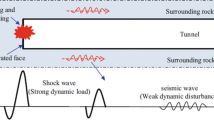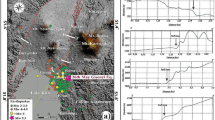Abstract
Reinforcing a landslide dam and converting a landslide-dammed lake to a hydraulically engineered lake is a sound means to address this natural disaster. The Hongshiyan landslide-dammed lake reconstruction project provides an excellent example. However, the stability of the remnant slope is crucial to the reconstruction of this project. It is essential to analyse the formation failure mechanisms of the Hongshiyan landslide and evaluate the stability of the remnant slope. Combined with field investigations and unmanned aerial vehicle (UAV) 3D image technologies, the failure mechanisms of the Hongshiyan landslide and the stability of the remnant slope were qualitatively studied and discussed. The dynamic process and failure mechanism of the Hongshiyan landslide are significantly different to conventional landslides. The dynamic process of the Hongshiyan landslide can be divided into three stages: time-dependent deformation stage, earthquake-induced failure stage and an unloading recovery stage. The failure mechanism can be summarised as follows: tension–crush–shattering–sliding. The stability conditions of the remnant slope are worse than those of conventional landslides under the same conditions. Toppling and small collapse are possibly occurring at the back scarp of the remnant slope because of the steep slope gradient, well-developed tension fractures and frequent occurrence of aftershocks and rainstorms. Based on the density, opening degree, porosity and connectivity of the cracks, as well as instability risk probabilities, the rock mass of the back scarp of the remnant slope can be divided into three zones: the seismically damaged zone, the unloading damaged zone and the stable zone. To guarantee the safety of the remnant slope and reduce secondary earthquake or rainstorm disasters, corresponding comprehensive treatment measures must be taken to ensure long-term stability.










Similar content being viewed by others
References
Alejano LR, Gómez-Márquez I, Martínez-Alegría R (2010) Analysis of a complex toppling-circular slope failure. Eng Geol 114(1):93–104
Ambraseys N, Srbulov M (1995) Earthquake induced displacements of slopes. Soil Dyn Earthq Eng 14:59–71
Ashford SA, Sitar N (1997) Analysis of topographic amplification of inclined shear waves in a steep coastal bluff. Bull Seismol Soc Am 87(3):692–700
Bandini V, Biondi G, Cascone E, Rampello S (2015) A GLE-based model for seismic displacement analysis of slopes including strength degradation and geometry rearrangement. Soil Dyn Earthq Eng 71:128–142
Biondi G, Cascone E, Maugeri M (2002) Flow and deformation failure of sandy slopes. Soil Dyn Earthq Eng 22(9):1103–1114
Bouckovalas GD, Papadimitriou AG (2005) Numerical evaluation of slope topography effects on seismic ground motion. Soil Dyn Earthq Eng 25(7):547–558
Brideau MA, Yan M, Stead D (2009) The role of tectonic damage and brittle rock fracture in the development of large rock slope failures. Geomorphology 103(1):30–49
Cai M (2008) Influence of intermediate principal stress on rock fracturing and strength near excavation boundaries—insight from numerical modeling. Int J Rock Mech Min Sci 45(5):763–772
Clague JJ, Stead D (2012) Landslides: types, mechanisms and modeling. Cambridge University Press, Cambridge
Dunning SA, Mitchell WA, Rosser NJ, Petley DN (2007) The Hattian Bala rock avalanche and associated landslides triggered by the Kashmir Earthquake of 8 October 2005. Eng Geol 93(3–4):130–144
Ehteshami-Moinabadi M, Nasiri S (2017) Geometrical and structural setting of landslide dams of the central Alborz: a link between earthquakes and landslide damming. Bull Eng Geol Environ. https://doi.org/10.1007/s10064-017-1021-8
Feng W, Xu Q, Huang R (2009) Preliminary study on mechanical mechanism of slope earthquake-induced deformation. Chin J Rock Mech Eng 28:3124–3130
Guan ZC (2009) Investigation of the 5.12 Wenchuan earthquake damages to the Zipingpu water control project and an assessment of its safety state. Sci China Ser E Technol Sci 52(4):820–834
Harp EL, Jibson RW (1996) Inventory of landslides triggered by the 1994 Northridge, California earthquake. Bull Seismol Soc Am 86(1B):S319–S332
Hong H, You J, Bi X (2016) The Ludian earthquake of 3 August 2014. Geomat Nat Haz Risk 7(2):450–457
Huang R, Xu Q, Huo J (2011) Mechanism and geo-mechanics models of landslides triggered by 5.12 Wenchuan earthquake. J Mount Sci 8(2):200–210
Keefer DK (1984) Landslides caused by earthquakes. Geol Soc Am Bull 95(4):406–421
Kobayashi Y, Harp EL, Kagawa T (1990) Simulation of rockfalls triggered by earthquakes. Rock Mech Rock Eng 23(1):1–20
Kramer SL (1996) Geotechnical earthquake engineering. Prentice Hall, Upper Saddle River, NJ
Li X, He S (2009) Seismically induced slope instabilities and the corresponding treatments: the case of a road in the Wenchuan earthquake hit region. J Mount Sci 6(1):96–100
Li HB, Liu MC, Xing WB, Shao S, Zhou JW (2017) Failure mechanisms and evolution assessment of the excavation damaged zones in a large-scale and deeply buried underground powerhouse. Rock Mech Rock Eng 50(7):1883–1900
Liu N (2015) Hongshiyan landslide dam danger removal and coordinated management. Front Eng Manage 1(3):308–317
Liu CZ, Ge YG, Jiang XY, Guo YY (2016) Dynamic analysis of the Hongshiyan collapse triggered by Ludian earthquake. J Disaster Prev Mitigation Eng 36(4):601–608
Lv Q, Liu Y, Yang Q (2017) Stability analysis of earthquake-induced rock slope based on back analysis of shear strength parameters of rock mass. Eng Geol 228:39–49
Pedersen H, Le Brun B, Hatzfeld D, Campillo M, Bard PY (1994) Ground-motion amplitude across ridges. Bull Seismol Soc Am 84(6):1786–1800
Rizzitano S, Cascone E, Biondi G (2014) Coupling of topographic and stratigraphic effects on seismic response of slopes through 2D linear and equivalent linear analyses. Soil Dyn Earthq Eng 67:66–84
Sepúlveda SA, Murphy W, Jibson RW, Petley DN (2005) Seismically induced rock slope failures resulting from topographic amplification of strong ground motions: the case of Pacoima Canyon, California. Eng Geol 80(3):336–348
Shi ZM, Xiong X, Peng M, Zhang LM, Xiong YF, Chen HX, Zhu Y (2017) Risk assessment and mitigation for the Hongshiyan landslide dam triggered by the 2014 Ludian earthquake in Yunnan, China. Landslides 14(1):269–285
Smith JV (2015) Self-stabilization of toppling and hillside creep in layered rocks. Eng Geol 196:139–149
Stead D, Wolter A (2015) A critical review of rock slope failure mechanisms: the importance of structural geology. J Struct Geol 74:1–23
Sun P, Li R, Jiang H, Igwe O, Shi J (2017) Earthquake-triggered landslides by the 1718 Tongwei earthquake in Gansu Province, northwest China. Bull Eng Geol Environ 76:1281–1295. https://doi.org/10.1007/s10064-016-0949-4
Wu Y, He SM, Li XP, Luo Y (2010) Failure mechanism and diagnosis method of dangerous crack rock after earthquake. J Sichuan Univ (Eng Sci Edition) 42(5):185–190
Xu Q, Dong XJ (2011) Genetic types of large-scale landslides induced by Wenchuan earthquake. Earth Sci J China Univer Geosci 36(6):1134–1142
Xu X, Xu C, Yu G, Wu X, Li X, Zhang J (2015) Primary surface ruptures of the Ludian Mw 6.2 earthquake, southeastern Tibetan plateau, China. Seismol Res Lett 86(6):1622–1635
Zhang S, Xie X, Wei F, Chernomorets S, Petrakov D, Pavlova I, Tellez RD (2015) A seismically triggered landslide dam in Honshiyan, Yunnan, China: from emergency management to hydropower potential. Landslides 12(6):1147–1157
Zhou JW, Xu WY, Yang XG, Shi C, Yang ZH (2010) The 28 October 1996 landslide and analysis of the stability of the current Huashiban slope at the Liangjiaren Hydropower Station, Southwest China. Eng Geol 114(1):45–56
Zhou JW, Cui P, Yang XG (2013) Dynamic process analysis for the initiation and movement of the Donghekou landslide-debris flow triggered by the Wenchuan earthquake. J Asian Earth Sci 76:70–84
Zhou JW, Lu PY, Hao MH (2015) Landslides triggered by the 3 August 2014 Ludian earthquake in China: geological properties, geomorphologic characteristics and spatial distribution analysis. Geomat Nat Haz Risk 7(4):1219–1241
Acknowledgements
This work is supported by the National Natural Science Foundation of China (41472272) and the Youth Science and Technology Fund of Sichuan Province (2016JQ0011). Critical comments by the anonymous reviewers greatly improved the initial manuscript.
Author information
Authors and Affiliations
Corresponding author
Rights and permissions
About this article
Cite this article
Li, HB., Li, XW., Ning, Y. et al. Dynamical process of the Hongshiyan landslide induced by the 2014 Ludian earthquake and stability evaluation of the back scarp of the remnant slope. Bull Eng Geol Environ 78, 2081–2092 (2019). https://doi.org/10.1007/s10064-018-1233-6
Received:
Accepted:
Published:
Issue Date:
DOI: https://doi.org/10.1007/s10064-018-1233-6




